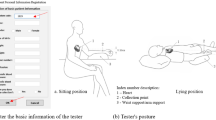Abstract
The digital pulse diagnosis system has been developed on the basis of a systematic pulse diagnosis method. This study has applied the diagnosis algorithm to 60 patients at an oriental medicine hospital. The diagnosis algorithm had been developed on the basis of the pulse wave data acquired through the sensor of the system. The test examined the patients’ pulse waves by the two methods of superficially and deeply checking them on the right and left wrists respectively. Since each method checked three parts of each wrist, which are Chon, Kwan, and Chuk, a total of 12 pulse waves were measured per patient. This study presents diagnosis parameters for clinical diagnoses by analyzing structural elements of pulse waveforms. As a result of having comparatively analyzed the result of 720 clinical data diagnosed by the digital pulse diagnosis system, developed by the study and the clinical results of oriental medicine doctors, the identical clinical opinion amounted to as much as 96.25%. The clinical application of the digital pulse diagnosis system developed by this study is of great significance in the sense that it heightened the objectivity and accuracy of the diagnosis. In the future, there should be continued research for establishing the pulse diagnosis database through incessant clinical tests.








Similar content being viewed by others
References
Sik, H. W., The Yellow Emperor’s classic of internal medicine SOMUN. Traditional Culture Research Association: Korea, 1992.
Back, H. S., Oriental pulse diagnostics. Electro-Pulse Graph Research Association: Korea, 1995.
Lee, J. Y., and Lin, J. C., A microprocessor-based noninvasive arterial pulse wave analyzer. IEEE Trans. Biomed. Eng. 22:57–60, 1980.
Shimazu, H., Noninvasive measurement of the volume elastic modulus in finger arteries using photoelectric plethysmography. IEEE Trans. Biomed. Eng. 33:795–798, 1986.
Wang Lin, Y. Y., Chang, C. C., and Chen, J. C., Pressure wave propagation in artery—A model with radial dilatation for simulating the behavior of a real artery. IEEE Eng. Med. Biol. 16(1):51–56, 1997.
Prior, A. J., Peck, K., Davies, P., and Beevers, D. G., Clinical evaluation of the sphygmomat 2 semiautomatic blood pressure monitor. J. Med. Eng. Technol. 14(6):250–253, 1990.
Lu, W. A., Lin, Y. Y., Lin, W., and Wang, W. K., Pulse analysis of patients with severe liver problems. IEEE Eng. Med. Biol. 18(1):73–75, 1999.
Willis, J. T., Biomedical digital signal processing. Prentice-Hall: Englewood Cliffs, NJ, 1993 (ISBN 0-13-143736-4).
Lee, J. Y., Kim, J. H., and Lee, M. H., Design of digital hardware system for pulse signals. J. Med. Syst. 25(6):385–394, 2001.
Charles, W. T., Discrete random signals and statistical signal processing: Prentice-Hall, International Editions, NJ, 1992 (ISBN 0-13-217985-7).
Marshall, R. J., The determination of peaks in biological waveforms. Comput. Biomed. Res. 19:319–329, 1986.
Dumpala, S. R., Reddy, S. N., and Sarma, S. K., An algorithm for the detection of peaks in biological signals. Comput. Programs Biomed. 14:249–256, 1982.
Gordone, E. C., Signal and linear system analysis. Houghton Mifflin Company: USA, 1992 (ISBN 0-395-51538-6).
Acknowledgment
This work was supported by Korea Research Foundation Grant (KRF-2004-003-E00288).
Author information
Authors and Affiliations
Corresponding author
Rights and permissions
About this article
Cite this article
Lee, J. The Study on the Intellectual Analysis Algorithm for Oriental Pulse Parameters. J Med Syst 31, 345–349 (2007). https://doi.org/10.1007/s10916-007-9074-z
Received:
Accepted:
Published:
Issue Date:
DOI: https://doi.org/10.1007/s10916-007-9074-z




